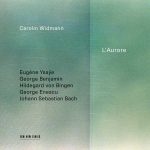

Composer: Johann Sebastian Bach
Performer: Esther Hoppe
Number of Discs: 2
Format: FLAC (tracks)
Label: Claves
Catalogue: CD3035
Release: 2022
Size: 2.52 GB
Recovery: +3%
Scan: yes
CD 01
Violin Sonata No. 1 in G Minor, BWV 1001
01. I. Adagio
02. II. Fuga. Allegro
03. III. Siciliana
04. IV. Presto
Violin Partita No. 1 in B Minor, BWV 1002
05. I. Allemande
06. II. Double
07. III. Corrente
08. IV. Double. Presto
09. V. Sarabande
10. VI. Double
11. VII. Tempo di Borea
12. VIII. Double
Violin Sonata No. 2 in A Minor, BWV 1003
13. I. Grave
14. II. Fuga
15. III. Andante
16. IV. Allegro
CD 02
Violin Partita No. 2 in D Minor, BWV 1004
01. I. Allemanda
02. II. Corrente
03. III. Sarabanda
04. IV. Giga
05. V. Ciaccona
Violin Sonata No. 3 in C Major, BWV 1005
06. I. Adagio
07. II. Fuga
08. III. Largo
09. IV. Allegro assai
Violin Partita No. 3 in E Major, BWV 1006
10. I. Preludio
11. II. Loure
12. III. Gavotte en Rondeau
13. IV. Menuet I & II
14. V. Bourrée
15. VI. Gigue
The Violin Sonatas and Partitas manuscript, which has fortunately survived, is dated 1720. The first page of the autograph carries the note “Libro Primo”; Bach’s Cello Suites BWV 1007-1012 may have been regarded as the “Libro Secondo”. A dedicatee is not known. Johann Sebastian Bach composed his Violin Sonatas and Partitas/ when he was employed as Kapellmeister in Köthen (1717-1723) and probably completed the cycle in 1720. There is hardly any other work in the entire violin literature with such significance. Bach set new standards in playing and composition; these works have lost none of their topicality and brilliance to this day.
Few composers had written works for unaccompanied violin before him, and indeed not entire cycles. However, it is assumed that Bach knew, for example, Johann Paul von Westhoff’s collection of Solo Violin Suites (1696). In his compositions, Westhoff had already attempted to create the illusion of bringing polyphonic music to life through an unaccompanied melodic instrument. Bach brought this art to an unsurpassable level of perfection in his Sonatas and Partitas.
The six Violin Sonatas and Partitas were already astonishingly widespread in the 18th century; many copies were produced. However, they only became widely known when the violinist Joseph Joachim, a close friend of Brahms, began to play them more frequently in the concert hall.
Excerpts from the booklet’s conversation with Esther Hoppe:
Jenny Berg: Johann Sebastian Bach’s Violin Sonatas and Partitas are part of the violin literature’s Olympus. All violinists have their own relationship to these works. What do they represent for you?
Esther Hoppe: For me, they have always been both beloved and awe-inspiring companions. When I was young, my approach was purely intuitive; little did I realise how many emotional and compositional intellectual layers were concealed within them. My main concern was solving technical aspects and playing the music “beautifully”. Later came a more differentiated preoccupation, which does not replace the original intuition but enriches it in a complementary way. The general engagement with Bach’s music is gratifying and challenging in a way that hardly any other music can offer.
Jenny Berg: Do you actually have a favourite piece in this whole big Bach cosmos?
Esther Hoppe: Oh, that is difficult. Out of these six works, the B minor Partita has become particularly close to my heart. It is less often played, probably because of its violinistic unwieldiness. And then, of course, there is the Ciaccona, the substantial core of the whole cycle.
During the recording process, the sound engineer Hans Kipfer and I sometimes paused to reflect on this music’s striking effect, simultaneously divine and earthly, complex and straightforward.



